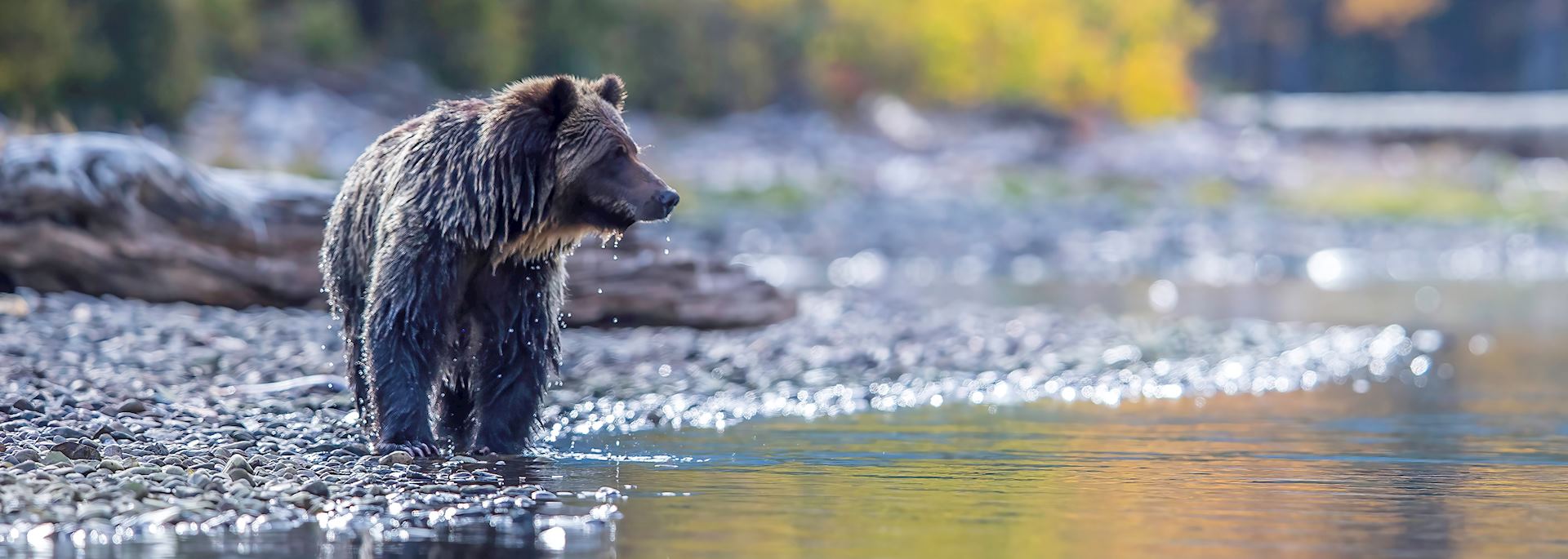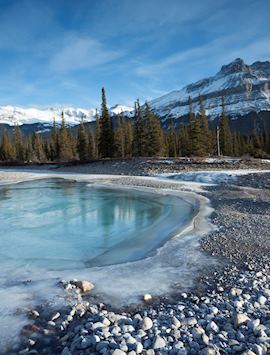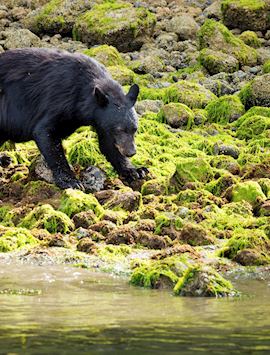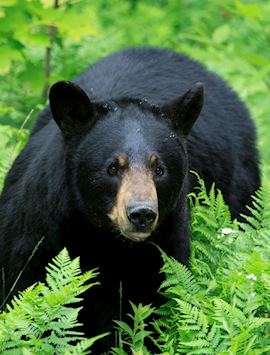Black, grizzly and the elusive spirit bear: all are found among Canada’s forests and mountains, and along the country’s wild western coastline. While there’s every chance of spotting one at the side of a road, our specialists reveal ways in which you can encounter them in a far more intimate and natural setting.
Where are the best places to see bears in Canada?
You can find bears across Canada, from the forests of Québec and New Brunswick to southern Manitoba and Alberta’s Rocky Mountains. But British Columbia is by far the best place to see them. You may be lucky enough to spot one at the side of the road, but for a far more intimate experience, head to the west coast.
Zodiac trips around Vancouver Island give you a chance to see black bears foraging along the shoreline. Alternatively, staying for a number of days at one of the bear lodges hidden within the Great Bear Rainforest lets you head out each day to see grizzly, black or even spirit bears up-close in their natural environment.
Bear lodges in British Columbia’s Great Bear Rainforest
Tweedsmuir Park Lodge, where Georgie stayed
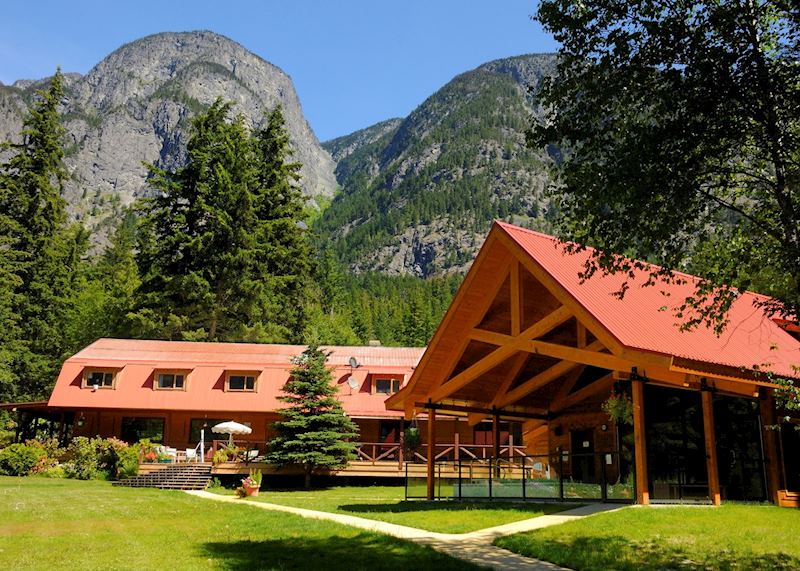
Getting to Tweedsmuir Park Lodge is all part of the adventure. You take a 70-minute scenic flight from Vancouver over snowy peaks embellished with jewel-like lakes, before coming to land between three remote valleys covered in temperate rainforest.
The lodge is close to the banks of the Atnarko River, with views of Mount Stupendous and Mount Melikan. Nothing and no one else is around — just you, a small number of fellow guests, and lodge staff. And, of, course, the wildlife.
You stay in your own timber-framed chalet — one of just ten — each with its own bathroom, air conditioning, and private setting surrounded by trees, meadows, and grassy areas where female bears are regularly spotted. There’s also a main lodge building where you can unwind between activities, complete with bar, games area, and rock fireplace. I liked the balance of modern comforts and simple outdoor living — there’s even a spa and an outdoor hot tub looking out across the nearby Coast Mountains.
One of Tweedsmuir’s main draws is its range of activities in addition to guided bear-watching outings (which are still, undoubtedly, the highlight).
You have the chance to explore the indigenous Nuxalk culture with First Nations guides, enjoy river activities like rafting and fishing, take via ferrata up to a mountain summit for views over surrounding peaks, or join heli-hiking trips into the mountains. The lodge also has its own herd of Icelandic horses for a different way to explore. It means you can come at any time of year and experience something new.
The guides here are passionate about this part of the world and true experts on its wildlife. They’ll often host evening presentations for you to learn more about the area’s natural history, geology, and First Nations traditions.
A typical day at Tweedsmuir Park Lodge
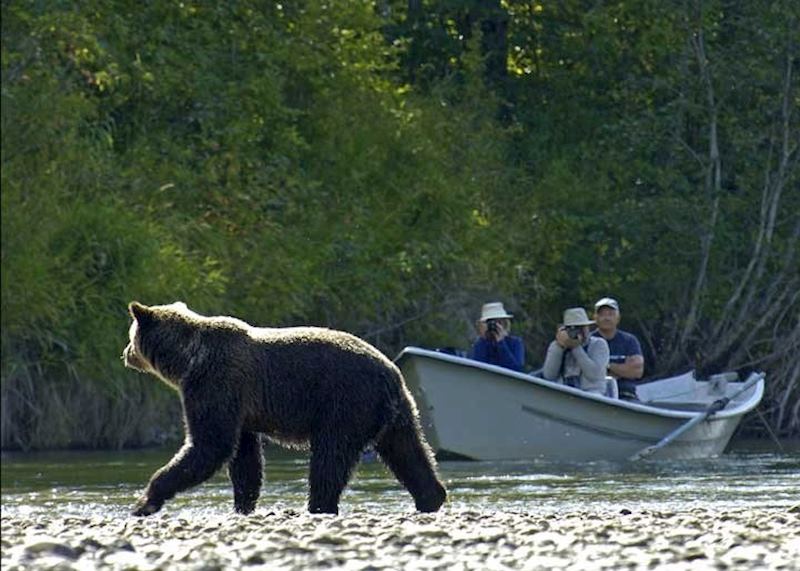
The variety of activities you can do from here means no day is the same, but you’ll generally wake to a cooked breakfast before heading out at around 8am in a small group led (private tours can also be arranged) by one of the lodge’s naturalist guides. All the guides are bear experts who can read the animals like a book and know the best places to see them.
Depending on the time of year and where bears have been active recently (your guides will have checked beforehand), you might travel by boat along the river or explore on foot through the rainforest. Your guide will help you look for signs of bear activity — pawprints in the mud, scat, and trees that have been used as a scratching post, their bark worn away or stuck with clumps of fur.
You’ll eventually arrive at a dedicated bear-viewing platform or hide set along a river. In September and October, salmon spawn here en masse, drawing solitary bears together for a feeding frenzy. I’ve seen up to a dozen at a time splashing in the water to scoop out their prize. As you watch, your guide interprets the bears’ actions and explains how they behave in their natural environment.
You’ll usually return to the lodge for lunch, before having some free time to relax — you could paddle a kayak or canoe, read a book by the fire, practise archery, or borrow a mountain bike to explore a local trail.
Your second guided activity of the day can focus on more bear watching, or you can choose from one of the other activity options. You could join a nature walk in search of other wildlife like moose, pine martens, and bald eagles, go e-biking, or drift peacefully down the river while honing your wildlife photography skills.
I recommend delving into the First Nations culture indigenous to the area during your stay. You’ll spend time with a First Nations guide who’ll show you totem poles and ancient petroglyphs carved by their ancestors in the forest. They’ll also share stories and songs passed down through generations.
Back at your lodge for the evening, you can share photos from your day with fellow guests and unwind with a drink. Then, it’s time for dinner: three courses of home-cooked fare made from local, sustainably sourced ingredients. You might even share the same diet as the bears, dining on freshly caught salmon.
Great Bear Lodge, where Emily stayed

It’s hard to feel any more out of the way than when you’re staying at Great Bear Lodge. Situated a half-hour seaplane flight north of Port Hardy, there’s nothing but rainforest and ocean for miles around.
After soaring over the Queen Charlotte Strait and its scattering of forested islands, we landed right outside the lodge — a two-storey wooden house floating out on the still water, set on a long stretch of decking.
The owners, Tom and Marg, believe in warm welcomes and will show you to your room — there are just eight. While simple (electricity usage is limited, with the lodge almost entirely powered by solar and wind energy), rooms are comfortable with a rustic, log-cabin feel, and have a small en suite with shower and toilet. Many look out over the water.
On my first evening I was treated to a dinner of fresh maple-glazed salmon roasted on a cedar plank with salad and yams, followed by chocolate lava cake. At breakfast you can expect eggs, fresh fruit and granola, while lunch is often a hearty soup with bread and salad. Complimentary drinks are on offer throughout your stay, and home-baked cookies are put out each day (help yourselves).
Regular natural history presentations are held in the communal lounge — all guides here are university-educated in subjects like ecology and biology, and experts in their field. I learned so much about the area’s wildlife and ecosystem, from identifying bird calls to discovering why bears rub themselves against trees (the main reason is to mark their territory).
A typical day at Great Bear Lodge
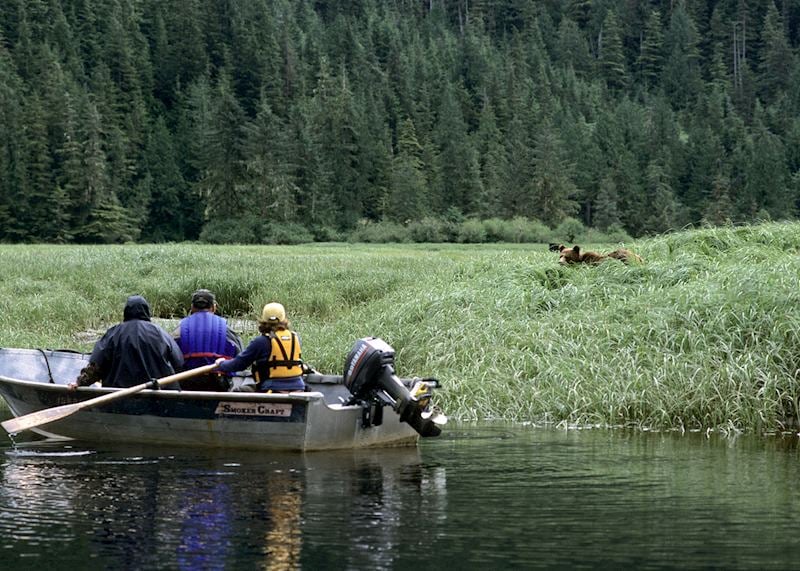
The focus here is purely on seeing bears and other wildlife. Cameras are set up at various locations around the forest to try to capture footage of the bears and keep track of them, so guides can take you out to see those they’ve located.
After an early breakfast, you join your guide (possibly on your own, or with a few others depending on guest numbers) for a three-hour trip to see bears.
The experience varies with the time of year. From May to early August you’re taken out by boat, but during the salmon run you make for strategically placed viewing platforms. Here, you can set up your camera or sit with a pair of binoculars and watch as the usually solitary bears come together to fish.
As I visited in July, the bears were filling up on sedge grass. They were skinnier than I’d imagined, but my guide reassured us that within a couple of months their bellies would be full of salmon.
We sat and watched a four-year-old sub-adult grizzly for a couple of hours as he climbed around on logs by the water and sat around grazing. This was exciting enough for me, having never seen a bear this close before. But then, without warning, he decided to climb into the water and swim right next to our boat. It was the best moment of my trip.
After lunch at the lodge, you head out on what the guides call a ‘mystery tour’. This could involve another boat trip to see bears, walking up to some viewing platforms, or following a bear trail to watch the tree-rubbing spectacle. Your guide can also explain techniques for tracking the bears.
You then go back for dinner before having the opportunity to join an evening bear-watching session or listen to a talk. Tom often joins you for a meal or a drink — I was enthralled by the tales he had to tell from his 20 years of living here.
The whole day is quite intensive, though you do have short breaks in-between the bear watching and you can opt out of some sessions to remain at the lodge.
On your final morning, you’re taken on a boat ride heading in the opposite direction toward the open ocean, passing waterfalls and looking out for other wildlife such as humpbacks, bald eagles, harbour seals and porpoises.
Other bear-watching experiences in Canada
By Emily
Seeing Bears by Zodiac in Clayoquot Sound, Vancouver Island
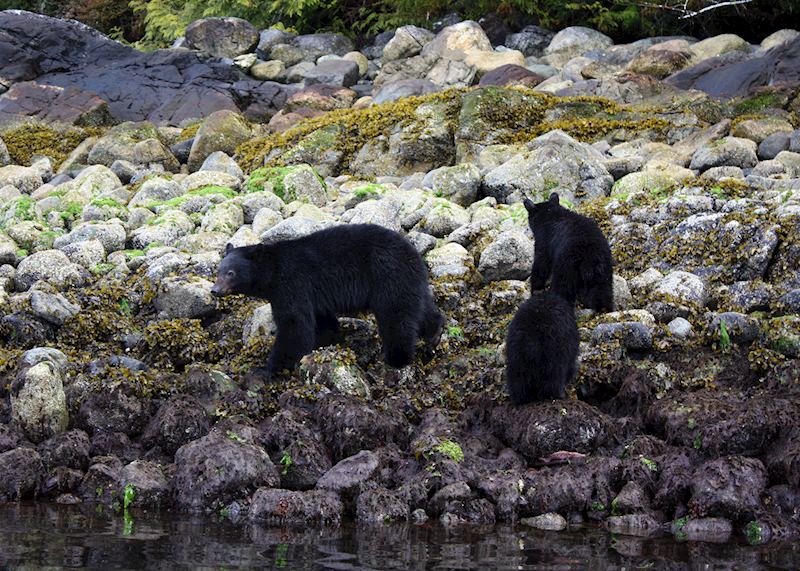
The sheltered waters of Clayoquot Sound — a UNESCO Biosphere Reserve — wash against the fir-covered rocks and wild sandy beaches of Vancouver Island’s west coast and its peppering of uninhabited islands. Low tide reveals the shoreline scattered with morsels left behind by the water, and opportunistic black bears take a stroll along the beach to take advantage of this open buffet.
Between April and October, you can join a two-and-a-half-hour bear-watching tour from Tofino aboard a 7 m (24 ft) Zodiac. These low-impact vessels can navigate into small bays and glide close to the shore without disturbing the bears as they turn over rocks and stones in their search for crabs, clams and barnacles.
Your guide will know the area inside out, and might even be able to identify individual bears. He or she can also tell you more about the life cycle, habits and diet of the bears, as well as helping you to spot other wildlife such as seals, eagles, porpoises, herons and orcas.
There’s also the option to join an extended whale- and bear-watching Zodiac tour, spending six hours out on the water in search of black bears and grey and humpback whales.
Campbell River and Bute Inlet boat trip, northern Vancouver Island
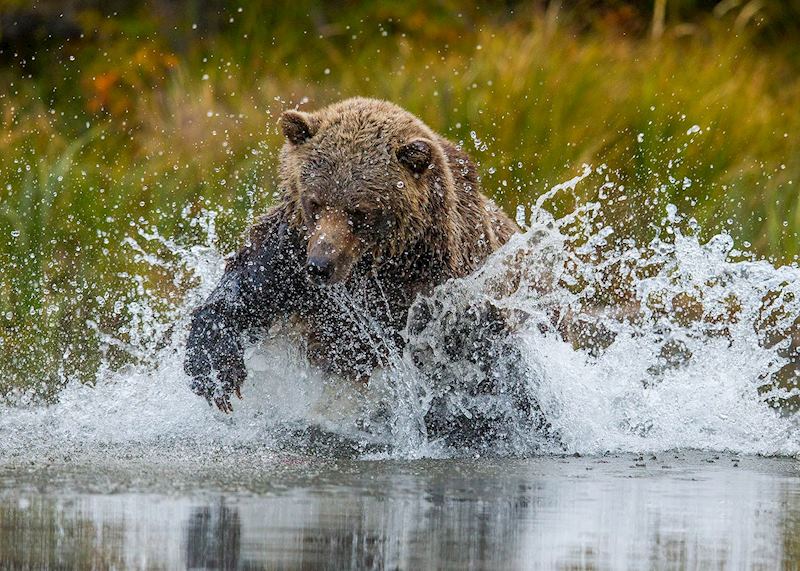
Just off Vancouver Island’s northeast coast lies a network of forested islands that have broken off from mainland British Columbia. Fjords flow between these shards of land and cut into the mainland, forming peaceful inlets that are a haven for wildlife. Bute Inlet is one of the largest, fostering around 40 resident grizzly bears. From late-August to late-October you can watch them grapple for salmon along the river.
High-speed boats and Zodiacs leave the town of Campbell River for a full day of exploring the inlet and its bears. You might see dolphins, orcas or humpbacks as you weave between islands and make your way along the inlet to the Orford River. Here, you’re met by Homalco First Nations guides, who’ll escort you to viewing platforms overlooking popular salmon-run spots.
As you watch the bears perfect their fishing techniques, your guides reveal more about them and their habitat. They can also answer any questions you have on First Nations culture in this area.
When is the best time to see bears in Canada?
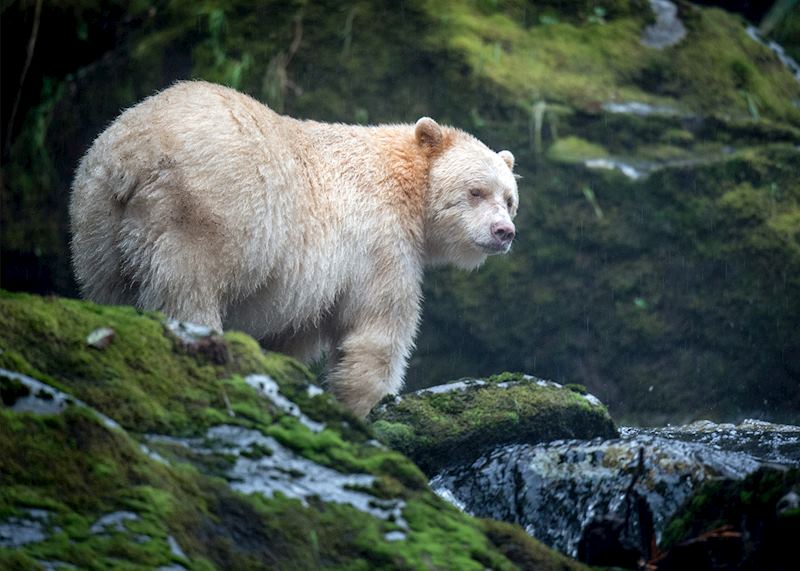
The best sightings occur between May and October, as bears hibernate during the winter months. They emerge in spring to mate and feed on berries, flowers and sedge grass. They might also catch the occasional fish, but it’s during the salmon run (late August to October) that the real feast begins.
You can watch the drama unfold as bears stab, scoop, and grab their meal from the rivers, slapping and splashing the water in their frenzy. It’s unsurprisingly a popular time of year to visit so you’ll need to book early.
What types of bear are found in Canada?

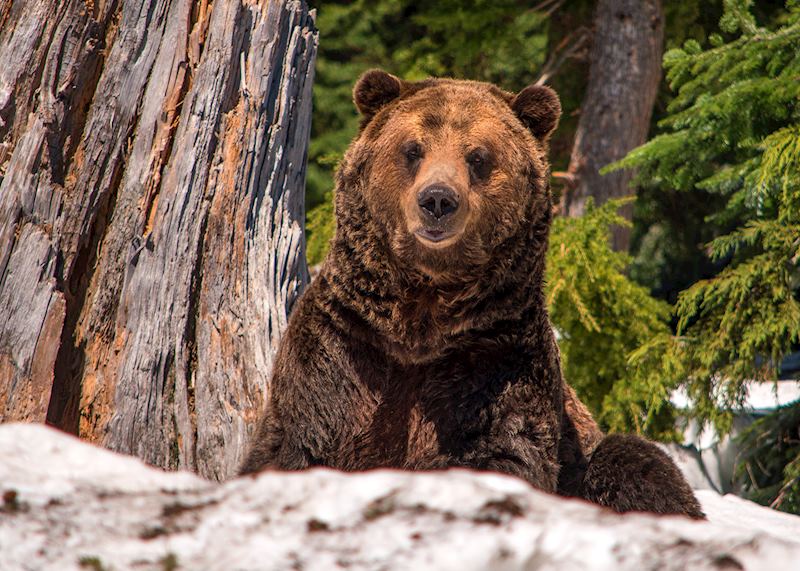
Black bears
- The most commonly spotted of Canada’s bears, they’re found throughout most of Canada.
- They prefer the solitude of the forest, but can sometimes be lured into towns in search of an easy meal.
- Excellent climbers — you might see a sow ushering her cubs up the nearest pine tree out of harm’s way.
Grizzly bears
- Fiercely territorial and often hard to find, and one of North America’s largest predators.
- Their thick coat of fur can vary in shade from blonde to dark brown, and they’ve a distinctive hump on their shoulders.
- They can live into their mid-twenties and follow quite solitary lives except during salmon-run season, when groups gather along riverbanks to catch their fill.
Kermode ‘spirit’ bears
- These white-coated bears are the rarest of all North American bear species.
- They’re actually black bears with a double-recessive gene that gives them their lighter shade; it’s possible to see a female spirit bear guiding her much darker black bear cubs.
- Revered by First Nations people, they’re only found in British Columbia’s Great Bear Rainforest.
Start planning your trip to Canada
Start thinking about your experience. These itineraries are simply suggestions for how you could enjoy some of the same experiences as our specialists. They're just for inspiration, because your trip will be created around your particular tastes.
View All Tours in Canada
